Nauclea orientalis
Nauclea orientalis is a species of tree in the family Rubiaceae, native to Southeast Asia, New Guinea, and Australia. It has many common names, including bur tree, canary wood, Leichhardt pine and yellow cheesewood.[2] It grows to a maximum of around 30 m (98 ft) in height and has large glossy leaves. It bears spherical clusters of fragrant flowers that develop into golf ball-sized edible but bitter fruits. The yellowish to orange soft wood is also used for timber and in woodcarving and folk medicine.
| Nauclea orientalis | |
|---|---|
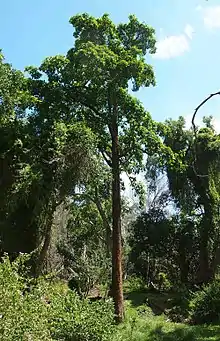 | |
| Leichhardt tree from Rockhampton, Queensland | |
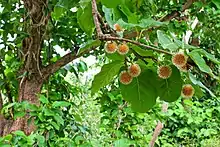 | |
| Leichhardt tree from Gregory National Park, Northern Territory | |
| Scientific classification | |
| Kingdom: | Plantae |
| Clade: | Tracheophytes |
| Clade: | Angiosperms |
| Clade: | Eudicots |
| Clade: | Asterids |
| Order: | Gentianales |
| Family: | Rubiaceae |
| Genus: | Nauclea |
| Species: | N. orientalis |
| Binomial name | |
| Nauclea orientalis | |
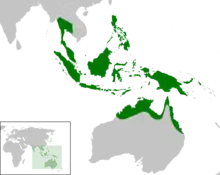 | |
| N. orientalis distribution map. | |
| Synonyms[1] | |
|
List
| |
Taxonomy and nomenclature
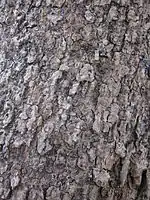
Nauclea orientalis is known by the common names Leichhardt tree, cheesewood, yellow cheesewood, and canary cheesewood. It is also sometimes known as the Leichhardt pine due to the overall shape of the tree, though it is not a conifer.[3] "Leichhardt pine", however, is more commonly used for the kadam or burrflower tree (Neolamarckia cadamba), a closely related species. The two were often confused together, but the native range of Leichhardt trees do not extend to India where kadam trees are common. It is known chiefly as bangkal in the Philippines. Regional variations of the name include balikakak, kabag, kabak, mabalot, and malbog.[4][5] It is closely related and sometimes confused with the bongkol or bulubangkal tree (Nauclea subdita). It is called kanluang in Thailand.[6]
Among the Djabugay people of Australia, they are known as gadugay. Among the Kuku Yalanji, they are known as kabal.[7] The Jawoyn people call it jirrib or wowerlk.[8] In various other languages of the Indigenous Australians, the names for Leichhardt trees include kaapi or kalpi in Pakanh, atulwanyj in Uw Oykangand, atulganyj in Uw Olkola. In avoidance speech (Uw Ilbmbanhdhiy or "respect language"), it is known as oboy in Uw Oykangand and opoy in Uw Olkola.[9]
The common name "Leichhardt tree" is from the German explorer Ludwig Leichhardt, who encountered the tree in his first expedition from Moreton Bay to Port Essington (from October 1, 1844 to December 17, 1845). He mistakenly identified it as a closely related Sarcocephalus and remarked on their preponderance near large riverbanks.[10]
Leichhardt trees belong to the genus Nauclea classified under the tribe Naucleeae, subfamily Cinchonoideae of the coffee family (Rubiaceae).
The species was first described as Cephalanthus orientalis by Carl Linnaeus in the first edition of Species Plantarum,[11] but was transferred to the genus Nauclea in the second edition in 1762.[12][1] The specific epithet orientalis means "eastern".[13] The generic name Nauclea comes from Greek naus ("ship") and kleio ("close"). It is unknown why, as no part of the plant is remotely boat-like.[14] A likely explanation is that Linnaeus was using different parts of plants when he first described the species and may have erroneously attributed a boat-like part of another plant to the species.[15] It might also be a reference to the shape of the fruit cells.[16] Many authors agree on the view that Linnaeus' description of C. orientalis in 1753 is mixture of true Nauclea orientalis and description by Hendrik van Rheede,[17] and true identity of the Rheede's plant (as Katou Tsjaca or Katou Tsjaka[18]) had been variously argued since at least 1798.[19][20][21] Colin Ernest Ridsdale discussed this matter and supposed that Rheede had intended to describe kadam.[21] The illustration of the Rheede's plant was later designated as the lectotype of kadam, i.e. Neolamarckia cadamba when Jean Bosser tried to solve the taxonomic problem of that species.[22]
Description

Leichhardt trees are medium to tall trees, reaching maximum height of around 30 m (98 ft) with a diameter of 1 m (3.3 ft). They are deciduous, shedding their leaves during the dry season.[23] The bark surface of Liechhardt trees are grayish to reddish brown and may be smooth or fissured and flaky. It is orange to yellow in color when cut.[15]
The broadly ovate smooth (glabrous) leaves are opposite and around 7 to 30 cm (2.8 to 11.8 in) by 4 to 18 cm (1.6 to 7.1 in) in size. The upper surface is glossy green. The bottom side has raised prominent yellow venation. Like most members of the family Rubiaceae, the stipules of Leichhardt trees are interpetiolar. In Nauclea, these interpetiolar stipules are held erect and pressed together, resulting in strongly flattened vegetative buds. They are large, around 1 to 3.5 cm (0.39 to 1.38 in) long. On their inside surfaces are a number of small red glands that can resemble insect eggs.[15]
The small fragrant flowers are tubular and are yellowish to orange with white stamens. They are grouped into a spherical cluster originating from a central point about 3 cm (1.2 in) in diameter. They bloom from September to January in Australia,[15] and August to October in the Philippines.[24] The individual flowers are small, about 8 to 10 mm (0.31 to 0.39 in) long and 3 to 5 mm (0.12 to 0.20 in) in diameter. They possess a perianth (each composed of five petals and sepals in separate whorls), The internal surface of the corolla are yellow to orange and sweet-smelling. They are frequently partly fused together, forming a long corolla tube tipped with the individual lobes of the petals. The flowers are bisexual, with 5 short and separate stamens attached to the perianth. The calyces are also fused together, resulting in the spherical shape of the flower head.[25] They are epigynous, with the ovary inferior (lying below the attachment of the other flower parts).[1]
After three months, the flower heads develop into a fleshy globular multiple fruit (syncarp) joined by their calyces (each flower becoming a fruitlet containing one seed). They are around 4 to 5 cm (1.6 to 2.0 in) in diameter, about the size of a golf ball.[1] The fruit is rugose (wrinkled), brown, and strongly aromatic. The fruits are indehiscent.[24]
The ovoid to ellipsoid seeds are small, around 1 to 10 mm (0.039 to 0.394 in) in length and are not winged. They are very numerous[25] but do not remain viable for long. Being recalcitrant (unable to survive drying and freezing temperatures), it's impossible to store them. The seeds germinate above ground (epigeal germination) around 15 days after being sown.[24]
Distribution and habitat
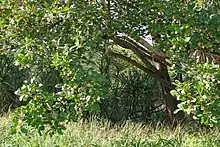
Leichhardt trees usually grow near bodies of water, as they prefer alluvial soils.[26] They can occur from shrublands of rheophytes, in areas often subjected to flooding, to rainforests where they flourish best. Leichhardt trees are pioneer species, settling areas leading to ecological succession. In Australia, they are usually associated in ecosystems including red gums and honey myrtles in drier habitats. In wetter areas they are associated with brush cherries, Moreton Bay chestnuts, and blush walnuts. They grow along with honey myrtles in swamps.[15] In the Philippines, Leichhardt trees are usually found growing in secondary forests.[24]
Leichhardt trees grow at elevations of 0 to 500 m (0 to 1,640 ft) above sea level.[6] Their native range extends from tropical Northern Australia and New Guinea to Southeast Asia; from the Philippines to Myanmar and Thailand (the biogeographic region of Malesia).[5] They are the only species of Nauclea occurring in Australia, though in some regions they can be easily confused with species from the genus Neolamarckia (= Anthocephalus auct. non A.Rich.).[15]
Uses
The tree is cultivated for ornamental purposes.[6] The fruits of the tree are edible and are eaten by Indigenous Australians, though it is very bitter-tasting. They are also eaten by flying foxes[27] and birds (like Cassowaries).[25][28]
In Malaysia, it is one of the food sources of proboscis monkeys (Nasalis larvatus), along with other members of Rubiaceae.[29]
The wood is easily cut (hence the common name of "cheesewood") but is not durable to weather exposure. It is distinctively yellowish to orange in color. The timber is used for frames and internal floorboards. It is also used in woodcarving, paper production, house construction, and for making canoes.[24][28]
The bark is also used to make fish poison.[30][31] The extract is added to slow-moving bodies of water to stun fish and make them easier to catch.[3][32]
In folk medicine, bark infusions cause vomiting and are used by Indigenous Australians to treat stomachaches and animal bites.[25] It is the source of a yellow dye.[28] In the Philippines, it is used to treat wounds.[4]
Studies on indole alkaloids extracted from Leichhardt trees have also pointed to possible antimalarial and anticancer effects.[33]
Pests and diseases
Leichhardt trees are susceptible to Lyctus beetles and blue stain fungus (Grosmannia clavigera). It is also reportedly vulnerable to termites.[24]
See also
- Fish toxins
- Nauclea diderrichii
- Neolamarckia cadamba, the kadam tree. A species commonly confused with the Leichhardt tree.
References
- Barry Conn & Kipiro Damas. "PNGTreesKey – Nauclea orientalis L." PNGTrees, National Herbarium of New South Wales and Papua New Guinea National Herbarium.
- USDA GRIN Taxonomy, retrieved 27 December 2015
- Dean McAdam; Andrew Pickering; Michael Barritt; Dave Rochford (2006). Vanda West (ed.). "The Explorer's Tree" (PDF). Junior Ranger Review. Northern Territory Parks and Wildlife Service, Northern Territory Government, Australia (3): 8–9. ISSN 1036-966X. Archived from the original (PDF) on April 9, 2011. Retrieved May 3, 2011.
- "Nauclea orientalis Linn. Bangkal". Bureau of Plant Industry, Department of Agriculture, Republic of the Philippines. Retrieved May 3, 2011.
- "Bangkal (Nauclea orientalis)". The Indi Journal: A Conservationist's Journal on Philippine Indigenous Flora. November 30, 2009. Archived from the original on December 4, 2010. Retrieved May 3, 2011.
- C. Orwa, A. Mutua, R. Kindt, R. Jamnadass, & S. Anthony (2009). Nauclea orientalis L. (Rubiaceae). Agroforestree Database:a tree reference and selection guide version 4.0 Archived 2009-01-16 at the Wayback Machine, World Agroforestry Centre. Retrieved May 3, 2011
- "Seed words in local language" (PDF). Wet Tropics Management Authority - Rainforest Explorer. Archived from the original (PDF) on June 1, 2011. Retrieved May 3, 2011.
{{cite journal}}: Cite journal requires|journal=(help) - "Jawoyn culture" (PDF). Nitmiluk National Park Tour Guide Handbook. Archived from the original (PDF) on 2011-03-20. Retrieved 2011-05-03.
- "Uw Oykangand and Uw Olkola Multimedia Dictionary". Kowanyama Aboriginal Community Council. Archived from the original on March 3, 2016. Retrieved May 7, 2011.
- R. J. Fensham; A.R. Bean; J. L. Dowe; C. R. Dunlop (2006). "This disastrous event staggered me: Reconstructing the botany of Ludwig Leichhardt on the expedition from Moreton Bay to Port Essington, 1844-45" (PDF). Cunninghamia. National Herbarium of New South Wales, Royal Botanic Gardens & Domain Trust, Sydney. 9 (4): 451–506. Archived from the original (PDF) on March 26, 2012. Retrieved May 3, 2011.
- Linnaeus, C. (1753). Species Plantarum (in Latin). Vol. 1 ([1st] ed.). Holmia[Stockholm]: Laurentius Salvius. p. 95.
- Linnæus, C. (1762). Species Plantarum: Exhibentes Plantas Rite Cognitas, ad Genera Relatas, cum Differentiis Specificis, Nominibus Trivialibus, Synonymis Selectis, Locis Natalibus, Secundum Systema Sexuale Digestas (in Latin). Vol. 1 (2 ed.). Holmia[Stockholm]: Laurentius Salvius. p. 243.
- Aboriginal Landcare Education Program (2010). "Recognise Plants" (PDF). ALEP Learning Guides. Greening Australia. 3: 10. ISBN 978-1-875345-96-0. Retrieved May 4, 2011.
- John Wilkes (1819). Encyclopaedia Londinensis. J. Adlard. p. 608.
- Douglas J. Boland; M. I. H. Brooker; G. M. Chippendale & Maurice William McDonald (2006). Douglas J. Boland (ed.). Forest trees of Australia. Csiro Publishing. pp. 650–651. ISBN 978-0-643-06969-5.
- Betsy Jackes (2003). Plants of Magnetic Island (3rd ed.). School of Tropical Biology, James Cook University of North Queensland. p. 11. ISBN 978-0-86443-705-1. Archived from the original on 2011-04-08. Retrieved 2011-05-04.
- van Rheede tot Draakestein, H. (1682). Hortus Malabaricus. Vol. 3. Amstelodamum. pp. 29, t. 33.
- cf. Malayalam: കാട്ടുചക്ക (kāṭṭucakka) “kadam; lit. 'wild jackfruit'”, ആറ്റുതേക്ക് (āṟṟutēkku) “kadam”
- Poiret (1798). "Nauclé à feilles de citronnier : Nauclea citrifolia. (N.)". In Lamarck (ed.). Encyclopédie méthodique. Botanique (in French and Latin). Vol. 4. Paris: H. Agasse. p. 435.
- Roxburgh, W. (1824). W. Carey (ed.). Flora Indica; or Descriptions of Indian Plants. Vol. 2. Serampore. p. 121.
- Ridsdale, C.E. (1976). "A revision of the tribe Cephalantheae (Rubiaceae)". Blumea. 23 (1): 184–185.
- Bosser, J. (1985). "Sur le type du Cephalanthus chinensis Lam.: Neolamarckia, nouveau nom pour Anthocephalus auct. non A. Rich. (Rubiaceae)". Bulletin du Muséum National d'Histoire Naturelle, 4e série, Section B, Adansonia, Botanique, Phytochimie (in French). 6 (3): 247.
- "Nauclea orientalis (L.) L." Ecology and Evolutionary Biology Plant Growth Facilities, University of Connecticut. April 1, 2011. Retrieved May 8, 2011.
- Maria Dayan; Rosalina Reaviles & Dolora Bandian (2007). "Indigenous Forest Tree Species in Laguna Province" (PDF). DENR Recommends. Ecosystems Research and Development Bureau, Department of Environment and Natural Resources. 15b: 12–13. Archived from the original (PDF) on August 15, 2011. Retrieved May 7, 2011.
- F.A. Zich; B.P.M Hyland; T. Whiffen; R.A. Kerrigan (2020). "Nauclea orientalis". Australian Tropical Rainforest Plants, Edition 8. Commonwealth Scientific and Industrial Research Organisation (CSIRO). Retrieved 21 March 2021.
- Jackes, Betsy (5 Oct 2012). "Nauclea orientalis (Leichhardt tree)". Discover Nature at JCU. Plants on Cairns Campus. Australia: James Cook University. Archived from the original on 26 November 2012. Retrieved 17 May 2013.
- Sam C. Stier (2003). Dietary Habits of Two Threatened Co-Roosting Flying Foxes (Megachiroptera), Subic Bay, Philippines (PDF) (Master of Science thesis). University of Montana. Archived from the original (PDF) on March 29, 2011. Retrieved May 7, 2011.
- John Chambers. "Leichhardt Tree". Chambers Wildlife Rainforest Lodges. Archived from the original on June 21, 2011. Retrieved May 3, 2011.
- Ikki Matsuda (2008). Feeding and Ranging Behaviors of Proboscis Monkey Nasalis larvatus in Sabah, Malaysia (PDF) (Ph.D. thesis). Hokkaido University. Retrieved May 7, 2011.
- F. N. Howes. "Fish poison plants". Kew Bull. FDA Poisonous Plant Database, U.S. Food and Drug Administration. 4: 129–153.
- Rashtra Vardhana (2006). Floristic plants of the world. Sarup & Sons. p. 581. ISBN 978-81-7625-651-3.
- Stella Martin, ed. (2002). "Out and about" (PDF). Tropical Topics: An Interpretative Newsletter for the Tourism Industry. Environmental Protection Agency, Queensland Parks and Wildlife Service (75): 7. Archived from the original (PDF) on March 19, 2011. Retrieved May 4, 2011.
- Jirapast Sichaem; Serm Surapinit; Pongpun Siripong; Suttire Khumkratok; Jonkolnee Jong-aramruang & Santi Tip-pyang (2010). "Two new cytotoxic isomeric indole alkaloids from the roots of Nauclea orientalis" (PDF). Fitoterapia. Elsevier. 81 (7): 830–833. doi:10.1016/j.fitote.2010.05.004. ISSN 0367-326X. PMID 20472039. Archived from the original (PDF) on March 23, 2012. Retrieved May 7, 2011.
External links
 Data related to Nauclea orientalis at Wikispecies
Data related to Nauclea orientalis at Wikispecies Media related to Nauclea orientalis at Wikimedia Commons
Media related to Nauclea orientalis at Wikimedia Commons